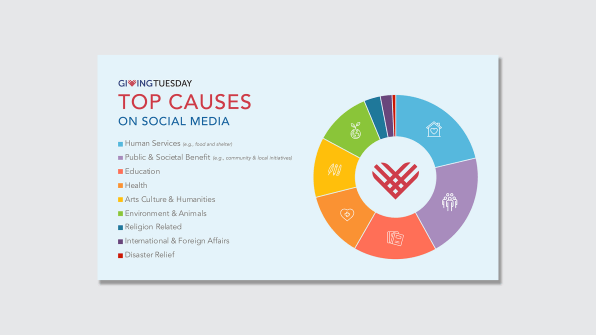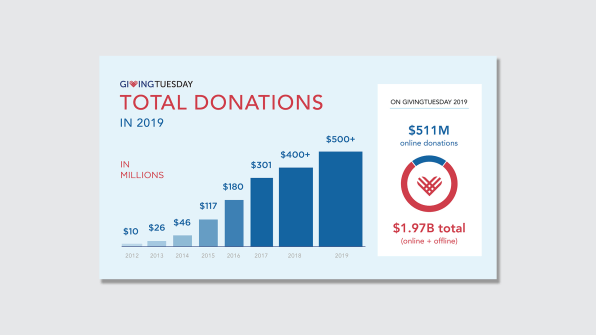This year’s Giving Tuesday online donations totaled a record high of $511 million
Here’s some good news to end 2019 on a positive note: this year’s Giving Tuesday online donations totaled a record-high of $511 million, up from $400 million in 2018, per the GivingTuesday Data Collaborative. Combined with offline donations, the organization behind the now-global day of generosity estimates that people gave a total of $1.97 billion on the Tuesday after Thanksgiving.
GivingTuesday used a new methodology this year to measure how many people got involved and found that 27 million adults participated, whether by donating or volunteering, in the United States alone. That’s equivalent to 13% of the entire U.S. adult population—and also nearly seven million more people than the entire population of Florida, the country’s third most populous state.
“Given that giving is trending downward overall, it was amazing and very inspiring to see that giving on Giving Tuesday once again grew by double digits,” says Asha Curran, GivingTuesday CEO. And it’s not just nonprofits and corporations playing a role. “There was a lot of activity [this year] at a very grassroots level, by which I mean people, just ordinary people in communities, really jumping into the idea of a day focused around generosity and a celebration of the impact that they feel that they can make on the world and their communities and the causes they care about.”

Shifts in tax policy and a volatile stock market has led to Americans giving less: In 2018, American households reduced their charitable giving by more than $15 billion, “the largest decline since the Great Recession,” according to NPR. And even when there are a lot of dollars being donated, it’s more consolidated, meaning more giving is being done by fewer and fewer people, says Woodrow Rosenbaum, data and insights lead for GivingTuesday.org.
And still, “every year, we see exactly the counter trend on Giving Tuesday, which I think is a really critically important indicator of what is possible,” he says, “and the untapped potential of generosity not just in the U.S. but around the world.”
One big group primed for that kind of generosity? Young adults. Every year, Giving Tuesday is particularly motivating to 19- to 34-year-olds, according to Rosenbaum, and that’s true in all 21 countries where his team has measured the statistics. “A lot of organizations find it’s really hard to engage that group, and there’s often a feeling that millennials are apathetic,” he says (though a lack of disposable income may also be a factor).

“When you actually look at their values, they’re actually much more positively inclined toward generosity and giving and charities and the charitable sector, they’re more likely to say they trust nonprofits, they’re more likely to say it’s important to give back, they’re more likely to say they enjoy giving.” At the same time, they’re less likely to say that giving is a priority, and so the momentum of an event like Giving Tuesday works well to engage that demographic.
Ultimately, Giving Tuesday is not a fundraising effort, because it’s not just about giving money; while 28% of Giving Tuesday participants gave money, 37% gave in ?other ways?, such as donating food or participating in clothing drives. Also, fundraising if often a one-and-done event—you give money and move on—but Curran hopes Giving Tuesday can be a movement of generosity movement and inspire a behavior change beyond the one calendar day. “One thing we’re seeing happen is this idea that Giving Tuesday is like a ritual, almost like a new holiday that people celebrate, and they celebrate together,” she says. “You can have a ritual more than once a year. We love that we’re seeing it organically crop up that Tuesday is becoming this day people wake up and think, ‘What good can I do for the world today?’”
(10)



